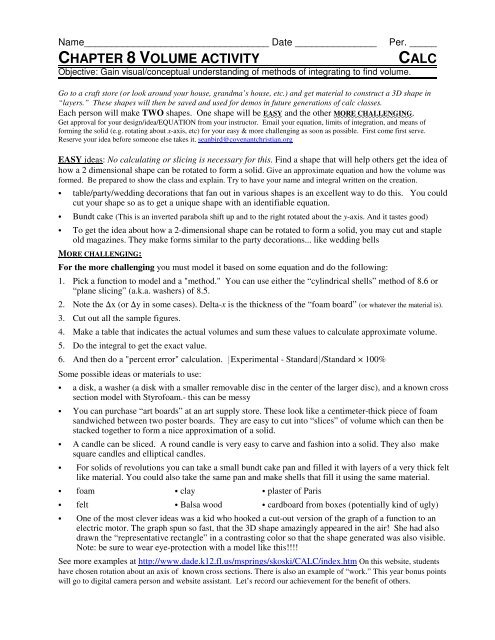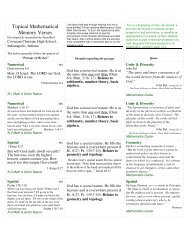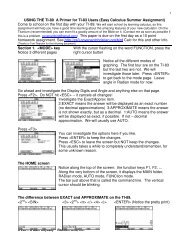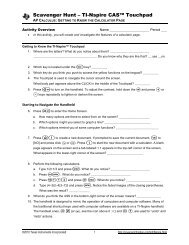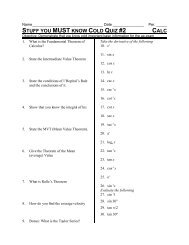You also want an ePaper? Increase the reach of your titles
YUMPU automatically turns print PDFs into web optimized ePapers that Google loves.
Name__________________________________ Date _______________<br />
CHAPTER 8 VOLUME ACTIVITY<br />
Objective: Gain visual/conceptual understanding of methods of integrating to find volume.<br />
Per. _____<br />
CALC<br />
Go to a craft store (or look around your house, grandma’s house, etc.) and get material to construct a 3D shape in<br />
“layers.” These shapes will then be saved and used for demos in future generations of calc classes.<br />
Each person will make TWO shapes. One shape will be EASY and the other MORE CHALLENGING.<br />
Get approval for your design/idea/EQUATION from your instructor. Email your equation, limits of integration, and means of<br />
forming the solid (e.g. rotating about x-axis, etc) for your easy & more challenging as soon as possible. First come first serve.<br />
Reserve your idea before someone else takes it. seanbird@covenantchristian.org<br />
EASY ideas: No calculating or slicing is necessary for this. Find a shape that will help others get the idea of<br />
how a 2 dimensional shape can be rotated to form a solid. Give an approximate equation and how the volume was<br />
formed. Be prepared to show the class and explain. Try to have your name and integral written on the creation.<br />
C<br />
C<br />
C<br />
table/party/wedding decorations that fan out in various shapes is an excellent way to do this. You could<br />
cut your shape so as to get a unique shape <strong>with</strong> an identifiable equation.<br />
Bundt cake (This is an inverted parabola shift up and to the right rotated about the y-axis. And it tastes good)<br />
To get the idea about how a 2-dimensional shape can be rotated to form a solid, you may cut and staple<br />
old magazines. They make forms similar to the party decorations... like wedding bells<br />
MORE CHALLENGING:<br />
For the more challenging you must model it based on some equation and do the following:<br />
1. Pick a function to model and a "method." You can use either the “cylindrical shells” method of 8.6 or<br />
“plane slicing” (a.k.a. washers) of 8.5.<br />
2. Note the )x (or )y in some cases). Delta-x is the thickness of the “foam board” (or whatever the material is).<br />
3. Cut out all the sample figures.<br />
4. Make a table that indicates the actual volumes and sum these values to calculate approximate volume.<br />
5. Do the integral to get the exact value.<br />
6. And then do a "percent error" calculation. *Experimental - Standard*/Standard × 100%<br />
Some possible ideas or materials to use:<br />
C<br />
C<br />
C<br />
C<br />
a disk, a washer (a disk <strong>with</strong> a smaller removable disc in the center of the larger disc), and a known cross<br />
section model <strong>with</strong> Styrofoam.- this can be messy<br />
You can purchase “art boards” at an art supply store. These look like a centimeter-thick piece of foam<br />
sandwiched between two poster boards. They are easy to cut into “slices” of volume which can then be<br />
stacked together to form a nice approximation of a solid.<br />
A candle can be sliced. A round candle is very easy to carve and fashion into a solid. They also make<br />
square candles and elliptical candles.<br />
For solids of revolutions you can take a small bundt cake pan and filled it <strong>with</strong> layers of a very thick felt<br />
like material. You could also take the same pan and make shells that fill it using the same material.<br />
C foam C clay C plaster of Paris<br />
C felt C Balsa wood C cardboard from boxes (potentially kind of ugly)<br />
C<br />
One of the most clever ideas was a kid who hooked a cut-out version of the graph of a function to an<br />
electric motor. The graph spun so fast, that the 3D shape amazingly appeared in the air! She had also<br />
drawn the “representative rectangle” in a contrasting color so that the shape generated was also visible.<br />
Note: be sure to wear eye-protection <strong>with</strong> a model like this!!!!<br />
See more examples at http://www.dade.k12.fl.us/msprings/skoski/CALC/index.htm On this website, students<br />
have chosen rotation about an axis of known cross sections. There is also an example of “work.” This year bonus points<br />
will go to digital camera person and website assistant. Let’s record our achievement for the benefit of others.
<strong>Volume</strong> <strong>Project</strong> <strong>Grading</strong> Form<br />
200 points<br />
We see shapes everywhere. Often the cost is associated <strong>with</strong> how much volume (material) is<br />
required to construct that object.<br />
One goal or motivation for this project is to be able to have a visual/conceptual understanding of<br />
volumes created by various integration methods. Students often have difficulty “seeing” the shape<br />
that is formed. A recommendation for a source of ideas for equations is the homework problems that<br />
will be assigned in section 8.5 & 8.6 or old AP problems. Making models for these problems may<br />
prove to be helpful in explaining these problems to future students.<br />
Due dates:<br />
Tuesday, January 24 Email equations deadline.<br />
Tuesday, February 6 “Easy” creation due.<br />
Day before chapter 8 test <strong>Project</strong> and paper due.<br />
Plan ahead. There will continue to be daily homework.<br />
Please make this paper the last page of your project for ease in grading.<br />
A<br />
‘ Go above and beyond: Possible ways you may do this is by<br />
- drawing impressive sketches.<br />
- Write a paragraph about what you have learned and why this was a worthwhile project - tell your<br />
story.<br />
- Impressive volume creation - e.g. you win the class competition of “Best of Show”<br />
- Your presentation is something special<br />
‘ You email your project and turn in a hard copy on or before the due date. (If you make a sketch for<br />
any part of the project, scanners are available to merge this electronically into your paper.)<br />
B<br />
‘<br />
Do all of the requirements for a C and do it correctly and neatly and on time.<br />
C<br />
‘ On your paper remind me of your EASY project by writing its equation and showing what it looked<br />
like. (A digital picture of this could be nice.) Label clearly “Easy <strong>Volume</strong>”.<br />
‘ Show equation and how your volume was created<br />
‘ Show data: )x or )y, “R”, cross sectional area, volume of slice. Total the volumes<br />
‘ Show work for integration. If you can not integrate it by the fundamental theorem of calculus, state<br />
that you numerically integrated.<br />
‘ Compare integral <strong>with</strong> approximation method. I.e. find percent error.<br />
‘ Draw at least the graph of your equation<br />
D<br />
‘ Not doing part or all of the above bullets, turning it in late, or not doing it right the first time<br />
F<br />
‘ do it again until it is passing


